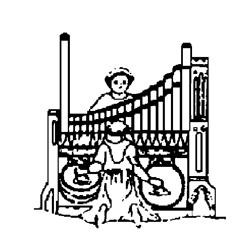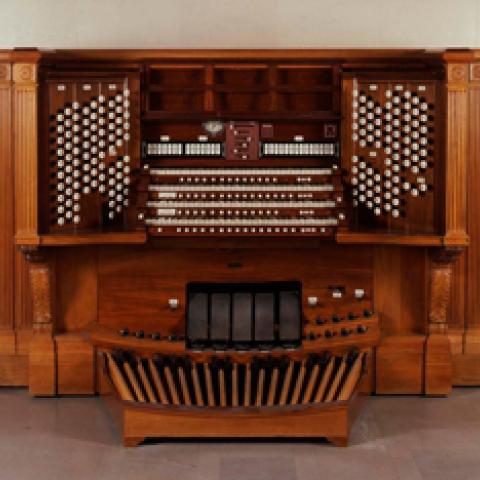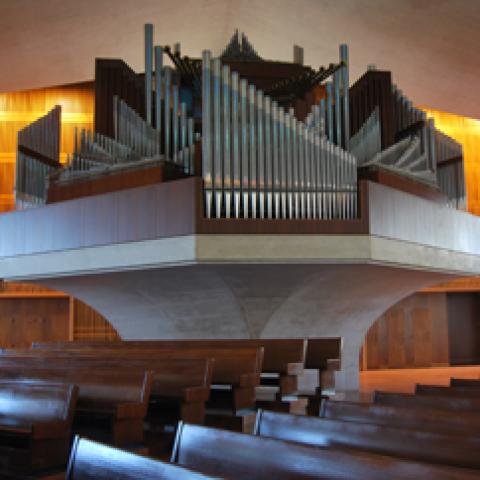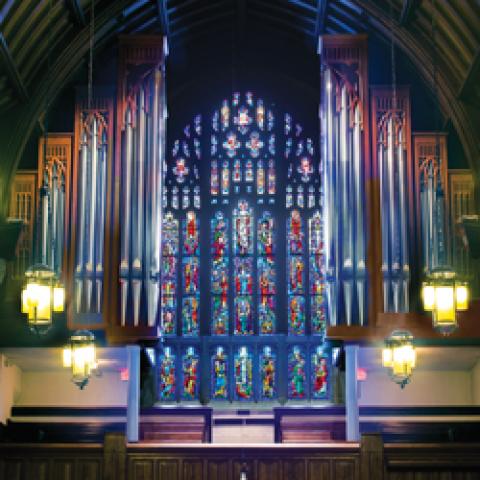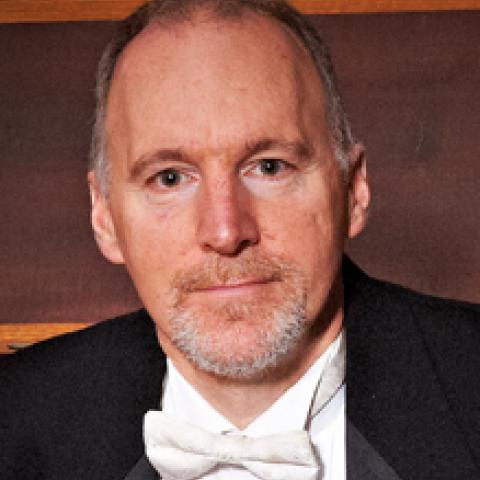The ninth biennial seminar attracted 80 participants who assembled in Paris anticipating the first week of playing time on the great instruments, lessons and classes with master teachers, participants' recitals, and the hospitality of our gracious hosts. At the Paris Conservatory, director Christina Harmon introduced co-director Marie-Louise Langlais, who received a warm round of applause. Participants introduced themselves and greeted old friends from previous seminars. Two student scholarship winners were announced: Josh Melson of Cherry Hill, New Jersey and a student at Centenary College in Shreveport, Louisiana; and Victor Johnson, a student at the University of Texas at Arlington and organist/composer-in-residence at Hamilton Park Baptist Church in Richardson, Texas.
The seminar always includes discourses about the instruments, improvisations by resident organists, and playing time for participants at the Schola Cantorum, Notre Dame de Paris, Les Invalides, Saint-Roch, La Madeleine, Sainte-Clotilde, La Trinité, Notre-Dame-des-Champs, Saint-Severin, Saint-Etienne-du-Mont, and Saint-Sulpice. The itinerary this year added visits to Notre Dame d'Auteuil, Saint-Augustin, Saint-Vincent-de-Paul, Saint-Eustace, and Dupré's home at Meudon.
Group and private lessons took place throughout the week with instructors Yanka Hekimova (Saint Eustace), Naji Hakim (La Trinité), Françoise Levechin (Saint-Roch), Lynne Davis (American Cathedral), François Espinasse (Saint Severin), Susan Landale (Les Inva-lides), and Marie-Louise Langlais (Sainte-Clotilde).
Participants who had contributed to the student scholarship fund were treated to a lovely wine and cheese reception at the apartment of Daniel and Odile Roth. Roth led everyone to his basement studio which houses a two-manual organ and a grand piano. The walls are filled with posters, memorabilia, and photographs, including those of Schweitzer, Widor, Bach, Franck, and Conrad Bernier. Letters and musical quotes from Kodály, Widor, Schmitt, Messiaen, Guilmant, and Deutilleux overlook the study. Later in the week, Roth, titular organist at Saint-Sulpice, would give the history of the instrument, improvise, and spend nearly six hours assisting participants to play.
Paris Conservatory
At the Conservatory, Jean-Charles Robin, 19-year-old student of Mme. Langlais, improvised on the tune "National Hymn" (God of Our Fathers), given an interesting twist by David Erwin who submitted it. Mme. Langlais solicited literature and performers for the participants' recital at St-Roch.
Saint-Augustin
Saint-Augustin, within short walking distance of the Paris Conservatory, was Gigout's church. He was titulaire there from 1863 until his death in 1925. Assistant organist Didier Matry played Gigout, a Cochereau improvisation, and his own improvisation.
Saint-Roch
Sylvie Mallet, David Erwin, and Mme. Langlais assisted for the recital at St-Roch. Advertised in the Paris weekly publication for arts events, the program attracted a great number of listeners. Eighteen participants played the marvelous four-manual, 53-stop, 1770 Clicquot instrument which was restored and enlarged by Cavaillé-Coll from 1840 to 1862. It boasts reeds which are among the most powerful in Paris. Literature included works by de Grigny, du Mage, François and Louis Couperin, Clérambault, Hakim, Vierne, Honegger, Langlais, Salomé, Widor, Sejan, and Lanquetuit. Performers included Mary Milligan (Denver, Colorado), Yolanda Yang (Irvine, California), Jay MacCubbin (Providence, Rhode Island), Helen Van Abbema Rodgers (Fairhope, Alabama), Shinook Lee (New York City), Josh Melson, Thomas Hanna (West Palm Beach, Florida), Jack W. Jones (Palm Beach, Florida), Esther Wideman (Philadelphia, Pennsylvania), Kay McAfee (Arkadelphia, Arkansas), Carl Schwartz (Silver Spring, Maryland), Eunice Ford (Huntsville, Alabama), David Erwin (Alexandria, Virginia), John Walko (San Francisco, California), Barbara Reid (Dallas, Texas), Lois Holdridge (Fullerton, California), Angela Kraft Cross (San Francisco), and Randy Runyon (Oxford, Ohio).
La Trinité
Naji Hakim, titular organist at La Trinité, was protégé and designated successor of Messiaen. New seminar participants as well as returning veterans enjoy the devotion of Parisian organists to the heritage of their instruments and the tribute paid their predecessors. None is more enthusiastic than Hakim. Guilmant's heritage at La Trinité includes the story of his horror at returning from America to find his instrument dismantled and destroyed. Cavaillé-Coll rebuilt the organ and today it exists as the instrument best suited for Messiaen's music.
Hakim played the outer movements of Messiaen's Messe de la Pentecôte. He spoke of Messiaen's improvisation and how he freely moved within many styles: Classical, Mendelssohn, Widor. The Livre du Saint Sacrement exploits Messiaen's improvisatory gifts. Hakim played his newest composition, The Last Judgement, which incorporates plainsong melodies: "Dies Irae," "In Paradisum," Alleluia of the Epiphany, and Gloria from Missa de Angelis. He improvised on "The Star Spangled Banner" since this group was there on July 4.
Notre-Dames-des-Champs
Marie-Bernadette Dufourcet, titular organist at Notre-Dame-des-Champs, treated participants to the sound of the 90% original Cavaillé-Coll design and disposition. It contains one of the most beautiful harmonic flutes and rich montres.
Saint-Vincent-de-Paul
At Saint-Vincent-de-Paul, where Léon Boëllmann served as titular organist, Marie-Louise Langlais introduced Pierre Cambourian, the current titulaire, who played the 1849 Cavaillé-Coll choir organ. Its action and stops have remained untouched and it enjoys exquisite balance of foundations, mutations, and reeds. Of three manuals with a short Récit, it has a beautiful harmonic flute, vox humana, and 16' basson on the Récit. The church was designed in the Neo-Classical style, after La Madeleine. The four-manual Cavaillé-Coll Grand Orgue, originally comparable to the La Madeleine organ, is now of Neo-Classical design, refurbished by Gonzalez in 1970, and nothing plays on the fourth manual. It is of 66 stops, although 91 were originally planned. Participants enjoyed generous playing time.
Saint-Louis des Invalides
In the evening the entire group gathered at Église Saint Louis des Invalides to hear informative discussion and playing by Susan Landale, who is one of three organists for the church. The Thierry family built the first instrument, a four-manual organ, from 1679 to 1687. The Clicquot family (who were also in the champagne business) looked after it. Louis XIV's architect, Jules-Hardouin Mansart, designed the case with its gilded sculptures. Some pipework remains from Thierry: the cromorne, fonds, bourdon and doublette in the Grand Orgue, and Positiv nazard and 2'. In 1843 a full-scale restoration was ordered. Three firms submitted proposals: Cavaillé-Coll, Ducroquet, and the winner of the contract, Gadault. Gadault built a third-rate Romantic organ, completely destroying the Classical organ of Thierry. There are, however, very fine reeds in the Swell. The Gadault organ was dedicated in 1853.
In 1942, Bernard Gavoty, a pupil of Dupré and a respected and feared music critic, was appointed organist at Les Invalides. He moved within elegant Parisian circles, and was the right person to collect money for a rebuild of the organ. In 1955, it was decided to engage the Beuchet-Debierre firm, which was instructed to build a Neo-Classical instrument. The console was electrified and the compass of manuals and pedals extended. The chamades were added in 1979.
According to Landale, the principal miscalculation of the Neo-Classical movement was the idea that if there were mixtures one could play Bach. It didn't matter if the mixtures didn't fit well with the foundations. The other problem was cramming a large amount of pipes into a small space (the original case) in order to get more ranks. As a result, the scaling went smaller and the sound was thinner. But to consider the music of Tournemire, Duruflé, Messaien, and Langlais from 1930 to 1970 is to hear music which was influenced by the Neo-Classical sound.
The last overhaul of cleaning and tuning the organ was in 1980. There are plans for another overhaul in 2003 which will include rewiring the organ. The organ contains 61 stops, including cornets on both the Great and Swell.
Ms. Landale discussed Tournemire, his work and his legacy, and played two of the improvisations: Ave Maris Stella and Te Deum. These improvisations had been recorded at Sainte-Clotilde to wax discs in 1913. Duruflé transcribed the improvisations in the 1950s. Besides the two Tournemire improvisations, Ms. Landale played a piece by Petr Eben, who followed Tournemire's lead in the prodigious use of Gregorian chant.
Sainte-Clotilde
The entire group assembled at Sainte-Clotilde to hear Marie-Louise Langlais discuss the organ, to hear participants play, and to enjoy a demonstration and improvisation by Jacques Taddei, titular organist of Sainte-Clotilde and director of the Paris Conservatory. Mme. Langlais met the group outside to talk about the history of the church.
The parish was wealthy and Cavaillé-Coll was engaged to build the organ. The organ is 46 stops, small by Cavaillé-Coll standards. Franck served as organist here from 1859-1890. Pierne served from 1890-1898, Tournemire from 1898-1939, and Langlais from 1945- 1987. Mme. Langlais mentioned that she tried to get Langlais to retire in the mid-1980s, as he really was not able to climb the steps to the loft. He declared that he was determined to "stay one year longer than Tournemire," and he did.
Tournemire was a devotee of Baroque music, both German and Spanish. He tried to transform the Sainte-Clotilde organ to accommodate these styles. In 1933, he enlarged the Positiv by adding mutations and he also directed enlargement of the Swell. This changed the balance of the organ. More changes were made by Langlais in 1962. With Jacques Taddei and Marie-Louise Langlais as consultants, the organ is currently undergoing yet another restoration. The goal is to return it as much as possible to the original Cavaillé-Coll voicing and disposition while maintaining the tonal design for playing also the music of Tournemire and Langlais. The organ builder in charge is Bernard Dargassies, who also has worked at Saint-Augustin, La Madeleine, and Saint-Étienne-du-Mont. Restoration of the original wind pressure, addition of a second motor for the blower, and restoration of the stop action is in process. The organ, and especially the 8' foundation ensemble, sounds more powerful, while the reeds have remained unchanged. At this point, the organ is as close to the original Cavaillé-Coll since the restoration by Tournemire in 1933.
David Erwin played the Franck E Major Choral using exclusively the Franck stops including signature stops of great beauty: vox humana, Swell trompette and hautbois combined, and the solo harmonic flute. Mme. Langlais played part of the Seven Words of Christ by Tournemire, and Angela Kraft Cross played "La Nativité" from the Poèmes Évangéliques by Langlais.
Mme. Langlais introduced Jacques Taddei, who demonstrated the solo and ensemble stops of the organ: 1. Positiv and Grand Orgue flutes in a scherzo; 2. The Récit gamba and celestes with the beautiful Positiv clarinet (really a cromorne); 3. Grand Orgue trumpet with fonds of the Récit; 4. Positiv cromorne with cornet of the Grand Orgue; 5. Ensemble of fonds of the Grand Orgue and Positiv and fonds of the Swell including oboe; 6. Flutes of the Grand Orgue and Récit which have been restored as harmonic flutes; 7. Restored larigot and 1', added by Tournemire in 1913, are now more integrated into the organ. Taddei then improvised on two themes submitted by Mme. Langlais: a Breton folk song and the hymn "If thou but suffer God to guide thee."
For the July 8 Sunday Mass at Sainte-Clotilde, six seminar participants were invited by Mme. Langlais to present musical offerings during the service. Literature included: Improvisation on Ave Maris Stella (Tournemire), Louise Bass (Albuquerque, New Mexico); Grand Jeu (Corrette), John Walko; Choral Dorien (Alain), Jack Jones; "Mon âme cherche un fin paisable" (from Nine Pieces, Langlais), John Walko; "Communion" (from Suite Médiévale, Langlais), Kay McAfee; Variations on a theme of Janequin (Alain), Jill Hunt (Evanston, Illinois); "Final" (from Symphonie I, Vierne), Angela Kraft Cross.
Saint-Sulpice
At Saint-Sulpice, a massive Roman style church with rounded interior arches, tourists are dazzled by the huge paintings in its side-chapels, two of them by Delacroix. The imposing case of the Grand Orgue, designed by the 18th-century architect of the church, Monsieur Chalgrin, matches the enormity and weight of the interior. Organists at Saint-Sulpice have included Guillaume Nivers, Clérambault, Lefébure-Wély, Widor, Dupré, Grunenwald, and presently, Daniel Roth. Clicquot built the first instrument in 1781. That organ was of five manuals: Half-Récit, Half-Echo, Récit, Bombarde, Grand Orgue, and Positiv. In 1835, a proposed restoration by Callinet was begun but was abandoned; 60,000 francs and twenty years later, Cavaillé-Coll undertook the project. At the time there were three organs in the church, the Grand Orgue, a Choir organ, and a smaller instrument owned by the Dauphin. Cavaillé-Coll restored all of them, and the choir organ survives today. The grand orgue is of 102 stops, including the original Clicquot pipework which Cavaillé-Coll carefully preserved. At the completion of the work in 1862, the dedication featured César Franck, Camille Saint-Saëns, Alexandre Guilmant, and Gaylord Schmidt (the titulaire at the time). In 1863 Lefébure-Wély was appointed organist, and when he died six years later, Cavaillé-Coll recommended Widor as titulaire. Because of Widor's youth (26) and the observation that "he plays like a German," many letters of protest were written. However, Widor was named "provisional" organist and remained for 63 years. Further maintenance of the organ occurred in 1903 (Mutin, Cavaillé-Coll's successor) and in 1991 (Renaud).
Neither Widor nor his successor Dupré (1933-1971) allowed any major changes in the pipework at Saint-Sulpice through the Orgelbewegung and neo-classic movements of the 20th century. Widor supervised cleaning of the organ three times and in the 1920s an electric blower was added. Dupré had the organ cleaned and repaired in the 1950s. The unbroken tenure of over 100 years by these two organist-composers effected the presence of a largely unaltered example of Cavaillé-Coll's tonal design.
Notre Dame d'Auteuil
At Notre Dame d'Auteuil in a quiet, upscale neighborhood close to the southwest boundary of Paris, Frédéric Blanc, who was one of the last students of Marie-Madeleine Duruflé, introduced Mme. Duruflé's sister, Elaine Chevalier. She is a member of the parish and head of the new Duruflé Foundation. Blanc, a gifted musician, has been titular organist here for 21⁄2 years. The organ is very special because it is an unaltered 1885 Cavaillé-Coll. Widor and Dallier played the inauguration. Mutin restored the organ in 1912 and again in 1937-38 under the direction of Vierne and with approval from Duruflé and Dupré. An electrified console was added.
The organ was virtually ignored through the Neo-Classical movement and managed to remain untouched, primarily because the organist who preceded Blanc was there for fifty years, and the instrument remained "closed." It is of three manuals and 53 stops with both Récit and Positiv under expression.
Blanc then conducted a session concerning the tradition of improvisation practiced by French organists who study the art from the time they are young children. Improvisation is always a mix of composition and freedom. Control is necessary, with effective use of stop combinations: flutes and fonds, solo stops with celestes, and with a mixture of counterpoint and chordal harmonies. Blanc: "Start simply. Control the harmony according to theoretical principles. A chosen theme should have both melodic and rhythmic interest. In preluding for the service or providing meditation for communion, there should be a plan for the shape of the form." He talked about how ideas come quickly for the good improviser and that those ideas have to be molded quickly. The time spent practicing improvisation will result in the tools for being free with those ideas that come quickly.
Saint-Étienne-du-Mont
Across from the Pantheon and near the beautiful Luxembourg Gardens is located Saint-Étienne-du-Mont, the church where Maurice and Marie-Madeleine Duruflé served for over 50 years. There was an organ here first in 1633 to which François Clicquot contributed. Today only the magnificent case survives along with some of the original Clicquot pipes. Randy Runyon, French professor at Miami of Ohio University, introduced and translated for Vincent Warnier, the talented young winner of the Grand Prix International d'Orgue de Chartres in 1992, who assumed the post of titulaire here upon the death of Mme. Duruflé.
Warnier related the history of the organ, which evolved very differently than other Parisian instruments. In the 19th century, when the romantic and symphonic sound was valued, Cavaillé-Coll was asked to restore the organ, the work for which was completed in 1863. He added many Romantic voices--fonds, harmonic flute, an expressive Récit with voix celeste--and a Barker machine.
In 1930, at age 28, Duruflé was named titlular organist. He arrived to find the organ virtually unplayable, and with Vierne and Dupré, they envisioned a restoration. But WWII intervened. Duruflé had to play a choir organ of only 12 stops for 25 years. In 1955 the organ was finally restored. Duruflé had been Vierne's assistant at Notre-Dame and he very much wanted to recreate that organ here. The 48 ranks became 90, and the new electrified console was placed to the right of the instrument.
Because the original case was small, the pipes were spread out. Above the west entrance doors, pipes are visible with some placed on their sides. The Echo manual is completely to the side of the original case, and gives a sense of mystery to the tonal palette. This is not an historical restoration, but the dynamic range is enormous, with impressionistic colors and an impressive tutti. In 1989, Mme. Duruflé enlisted the Dargassies firm to restore the organ. At that time the console was further modernized, mixtures were revoiced, and fonds and an en chamade were added. Today the organ is an eclectic instrument.
La Madeleine
At La Madeleine, François Henri-Houbart, titular organist for the past 22 years, related the history of the colorful musicians and composers who have served this most civic and visible of Parisian churches. During Lefébure-Wély's era in the early 19th century, the church was considered "an annex of the Opéra Comique," because the music heard was often of the salon and theatrical varieties. When Houbart arrived, the organ was in a poor state of repair. Houbart oversaw a restoration of the windchests, the restoration of the wind pressure as prescribed by Cavaillé-Coll, and the modification of the newer stops so that they integrate well within the original pipework.
The organ (1845-46) is Cavaillé-Coll's second large instrument after Saint-Dénis and Notre-Dame-de-Lorette. This instrument, originally of 48 stops, represents the transition to the Romantic-symphonic ethos of Cavaillé-Coll. The fonds, reeds, and plein jeu provide a Classic foundation (after Dom Bédos). There is no cromorne or cornet. The Récit is the same as Sainte-Clotilde but without the voix celeste. The organ has a large quantity of flutes, especially harmonic flutes, representing Cavaillé-Coll's transition to the orchestral organ. Today the organ has 58 stops, with 46 from the original instrument.
The organ underwent a restoration in 1927 for which Widor played the dedicatory recital. The program included his Suite Latine, which was written for the occasion. The console was electrified in 1971. The heritage of organists include Fessy, Lefébure-Wély, Saint-Saëns, Dubois, Fauré, Dallier, and Demes-sieux. Fauré was first the choir organist and he assisted Saint-Saëns. When Fauré became titulaire, Nadia Bou-langer was his assistant. Clara Schumann, Franz Liszt, and Anton Rubenstein frequented the organ loft.
The choir organ was also built by Cavaillé-Coll. At first it had only one keyboard, but he added another to encompass 20 stops. It was restored in 1997. The bassoon, oboe, and clarion are original stops. Houbart's fine improvisation included demonstration of the Cavaillé-Coll stops, then of the newer stops, then all together. Houbart related that once every three years he plays an all-Lefébure-Wély Mass, which he would do that evening at 6 pm, Sunday at 11 am, and Sunday evening at 6 pm. For participants who wanted to attend, about ten people at a time could visit the organ loft. He mentioned that Lefébure-Wély wrote a number of excellent anthems and choral music for the Mass, and that Saint-Saëns, who was a detractor, actually admired his improvisations.
Schola Cantorum
At the Schola Cantorum, Mme. Langlais told of the school and its Mutin organ (Mutin took over the firm after Cavaillé-Coll's death). Founded in 1896 by Charles Bordes, Alexandre Guilmant, and Vincent d'Indy, it was established for the study of the restoration of Gregorian chant after Solesmes and to re-introduce the Grand Orgue. The Schola was not as competitive as the Conservatory. A temple of "non-official" music, teachers included Guilmant, Vierne, the Duruflés, Grunenwald, Langlais, Satie, Martin˚u, and Turina. Students included Milhaud, Roussel, and Debussy.
One of Mme. Langlais's students, Verouchka Nikitine, played a fine recital which included Vierne, "Allegro et Cantilene" (Symphonie 3); Widor, "Allegro" (Symphonie 6); Langlais, "Communion" (Suite Médiévale); and Jean-Louis Florentz (b. 1947), two movements from Laudes. Participants enjoyed a light buffet supper prepared by Mme. Langlais and her daughter Caroline.
Participants chose among several churches to attend Sunday morning. The afternoon event was a recital at Notre-Dame-de-Paris which consisted of music of Mendelssohn and Bach. The church was full and pleasantly respectful as the recital proceeded. The organist experienced difficulty with registration changes, and it was somewhat disappointing to hear an all-German recital on this, the largest instrument in Paris. Playing time was allowed after the cathedral closed its doors to the public.
Saint-Étienne, Caen, Chartres
Participants boarded a bus for the 200 kilometer drive through the lovely countryside to Normandy and the city of Caen. Saint-Étienne houses a large Cavaillé-Coll instrument which is a-mong the three finest and largely unaltered organs of the builder. The others are at Saint-Sulpice and at Saint-Ouen in Rouen. Phillip Klais, president of the Klais firm of Bonn, Germany, introduced tonal director Heinz-Gunter Habbig. Habbig studied with the last voicer of the Cavaillé-Coll tradition, and he has made extensive studies of the organs at Saint-Ouen, Saint-Omer, Saint-Sulpice, and Saint-Sernin. Habek has directed several Cavaillé-Coll restorations, and his presentation of this instrument and discussion of the Cavaillé-Coll ethos was filled with reverence for the work of such a master craftsman.
The Abbey Church of Caen was a famous center of art education in the Middle Ages, but there is no record of an organ until the 15th century. In May of 1562, Protestants ransacked the church and ruined the organ. 200 years later, in 1737, the monks engaged a builder in Ouen and that organ's oak case, from 1741, its towers crowned with flower pots, remains today. On February 10, 1745, the organ was completed, a remarkable 18th-century specimen with five manuals and 61 stops. The first three manuals had a compass of 53 notes, a first in France, and the pedal was complete with a 16' and cornet.
The organ was endangered during the French revolution but suffered only neglect. In 1859 there was a restoration, and by 1877 more repairs were needed, and Cavaillé-Coll was asked to give an opinion. It was decided, with approval of Guilmant, that the old case and old façade pipes would be retained, with an addition of 8 stops. New wind chests and blower, new action, and new pipework were built in one year; the manual compass was increased to 56 notes. On March 3, 1885, Guilmant played the dedication recital. Repairs were needed in 1899 and the organ was given excellent care through to 1944. In January of 1975, the Secretary of Culture placed the instrument on the National Register of Historic Monuments. In 1998-99 there was another restoration.
Lynne Davis, a native of Michigan who has lived in France for 30 years, has for five years been Professor of the National Regional Conservatory at Caen. She studied with Marie-Claire Alain, Jean Langlais, and the Duruflés. Her studio of 20-25 students is privileged to practice and take lessons at Saint-Étienne and also to play the choir organ which is a Baroque instrument. After speaking of her immense affection for this great instrument, Ms. Davis played "Nef" and "Rosace" from Byzantine Sketches by Mulet, Cantabile by Franck, and Toccata by Vierne. Participants were then allowed generous playing time.
Part of the group continued on to Chartres to hear assistant organist Laurent Bois play and then all had the opportunity to play the great 1971 Danion-Gonzalez organ of 69 stops.
Participants returned to Paris and prepared to depart for Alsace for the second week of the French Organ Music Seminar.
(A report on the Alsace week will appear in a later issue of The Diapason.)
